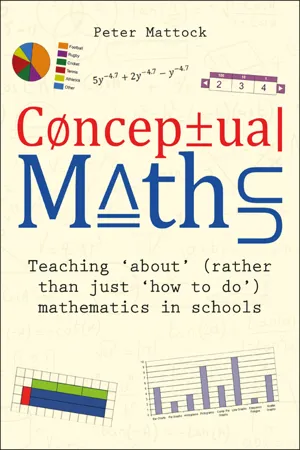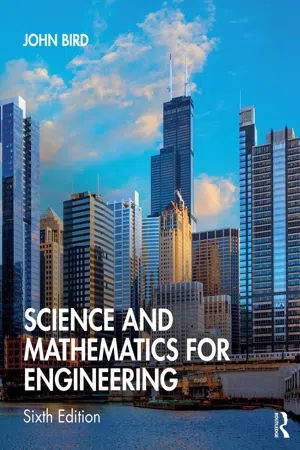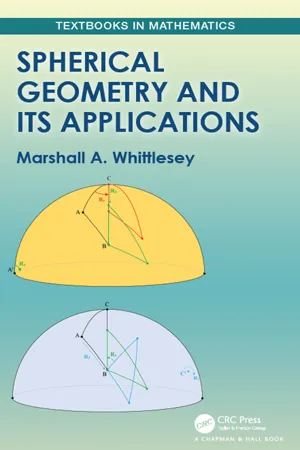Mathematics
Surface Area of Sphere
The surface area of a sphere is the total area of the outer surface of the sphere. It is calculated using the formula 4πr^2, where r is the radius of the sphere. This formula represents the sum of all the individual areas of the infinitesimally small pieces that make up the surface of the sphere.
Written by Perlego with AI-assistance
Related key terms
3 Key excerpts on "Surface Area of Sphere"
- eBook - ePub
Conceptual Maths
Teaching 'about' (rather than just 'how to do') mathematics in schools
- Peter Mattock(Author)
- 2023(Publication Date)
- Crown House Publishing(Publisher)
However we arrive at it (including potentially just providing the formula directly), one important aspect of the surface area formula that pupils should appreciate (either through their own insight or having been explicitly taught it) is that the surface area of the sphere is four times bigger than that of the circle created by the equator of the sphere. Offering pupils a question like the one below might prompt this awareness or might be used to reinforce it if the relationship has been explicitly taught:A sphere is cut into two pieces along the equator to form two hemispheres as shown. Each hemisphere rests on the circular base with an area of 200 cm2 . Find the surface area of the original sphere.Of course, this question can be adapted to ask for things like the difference between the surface area of the original sphere and the two hemispheres, or even the ratio of the surface area of the original sphere to the two hemispheres. This sort of question can be combined with more traditional questions that provide the radius of the sphere for direct surface area calculations.387As with circles, there are lots of directions pupils can take the study of surface area of curved shapes. All three formulae involve the radius of the sphere in the calculation of surface area; pupils could rewrite these using diameter or even circumference (although care should be taken here not to confuse measures of length with measures of area). The surface area of a cylinder is particularly nice when written in terms of the circumference of the base circles, being just Cr + Ch (where C is the circumference), whilst the sphere might prove slightly more challenging – particularly if we ask pupils to demonstrate that it can be written as In addition, the usual part shapes or combined shapes can provide further practice whilst forcing pupils to consider how to adapt the formulae to correctly calculate the surface area; the classic of these is the pencil modelled as a combination of the cone, cylinder and hemisphere:A pencil is modelled as a cone, cylinder and hemisphere joined together. Find the total surface area of the pencil. - eBook - ePub
- John Bird(Author)
- 2019(Publication Date)
- Routledge(Publisher)
theorem: l = 1 2 2 + 5 2 = 1 3 cm Hence, total surface area = (π × 5 × 1 3) + (π × 5 2) = 282.7 cm 2 14.2.6 Spheres For the sphere shown in Figure 14.13 : Volume = 4 3 π r 3 and surface area = 4 π r 2 Figure 14.13 Problem 14. Find the volume and surface area of a sphere of diameter 10 cm Since diameter = 10 cm, then radius r = 5 cm. Volume of. sphere = 4 3 π r 3 = 4 3 × π × 5 3 = 523.6 cm 3 Surface Area of Sphere = 4 π r 2 = 4 × π × 5 2 = 314.2 cm 2 Problem 15. The surface area of a sphere is 201.1 cm 2. Find the diameter of the sphere, and hence its volume Surface Area of Sphere = 4πτ 2. Hence, 201.1 cm 2 = 4 × π × r 2 from which, r 2 = 2 01.1 4 × π = 16.0 and radius r = 16.0 = 4.0 cm from which, diameter = 2 × r = 2 × 4.0 = 8.0 cm Volume of sphere = 4 3 π r 3 = 4 3 × π × (4.0) 3 = 268.1 cm 3 Now try the following Practice Exercise Practice Exercise 64 Volumes and surface areas of common shapes (answers on page 538) 1. If a cone has a diameter of 80 mm and a perpendicular height of 120 mm, calculate its volume in cm 3 and its curved surface. area 2. A square pyramid has a perpendicular height of 4 cm. If a side of the base is 2.4 cm long find the volume and total surface area of the pyramid 3. A sphere has a diameter of 6 cm. Determine its volume and surface area 4. A pyramid having a square base has a perpendicular height of 25 cm and a volume of 75 cm 3 Determine, in centimetres, the length of each side of the base 5. A cone has a base diameter of 16 mm and a perpendicular height of 40 mm. Find its volume correct to the nearest cubic millimetre 6. Determine (a) the volume, and (b) the surface area of a sphere of radius 40 mm 7. The volume of a sphere is 325 cm 3. Determine its diameter 8. Given the radius of the earth is 6380 km, calculate, in engineering notation (a) its surface area in km 2 and (b) its volume in km 3 9. An ingot whose volume is 1.5 m 3 is to be made into ball bearings whose radii are 8.0 cm - eBook - ePub
- Marshall Whittlesey(Author)
- 2019(Publication Date)
- Chapman and Hall/CRC(Publisher)
Chapter 2The sphere in space
We begin our study of spherical geometry by noting two different ways of presenting the subject, both of which we consider in this book.We may first consider a sphere the way most people understand it: as a round object that lives in three-dimensional space. By doing so, we may use the tools of three-dimensional geometry, trigonometry, and vectors to learn about the sphere. This we will call an extrinsic approach to spherical geometry. An understanding of it is particularly important in applications. On the other hand, we may study spherical geometry via the intrinsic properties of the sphere — that is, properties of the sphere that can be thought of without reference to the larger three-dimensional space in which a sphere sits. It will be our main goal to do this in Chapter 3 .We begin by looking at the extrinsic properties of the sphere in this chapter. As we do so, it will be important to understand how to see these properties as intrinsic, and hence motivate the axiom system that we set up in Chapter 3 .5 Great circles
Definition 5.1 Let O be a point in space and r a positive real number. The sphere with center O and radius r is the set of all points in space which lie at distance r from O.The following proposition summarizes the properties of intersections between spheres and planes in space.Proposition 5.2 The intersection between a sphere and a plane in space is a circle, a point, or the empty set.In Figure 2.1 we may see these possibilities geometrically by considering the line in space through the center O of the sphere perpendicular to the plane at point P. We distinguish four cases: P is outside the sphere, on the sphere, interior to the sphere but different from O, or equal to O. In the first case, every point in the plane is outside the sphere because P = P1 is the closest point on the plane to O — hence every point on the plane is at a greater distance from O than the radius. If P = P2 is on the sphere, then the plane is tangent to the sphere, hence meets it in a single point. In the case of P = O, the intersection of the sphere with the plane is the set of all points in the plane at a fixed distance from O. This is a circle. Lastly, suppose P = P3 is inside the sphere, but different from O. Then let X be any point on the intersection of the plane and the sphere, let r be the radius of the sphere, and let d be the distance between P3 and O. Then ΔOP3 X has a right angle at P3 , so the length ofmust be¯P 3X. Thus the points on both the plane and sphere all lie at the same distance from P3 , so lie on a circle. To be complete, we must show that all points in the plane at distancer 2−d 2from P3 are also on the sphere; this is left as an exercise. So the intersection of the plane and the sphere is a circle of radiusr 2−d 2r 2−d 2
Learn about this page
Index pages curate the most relevant extracts from our library of academic textbooks. They’ve been created using an in-house natural language model (NLM), each adding context and meaning to key research topics.


